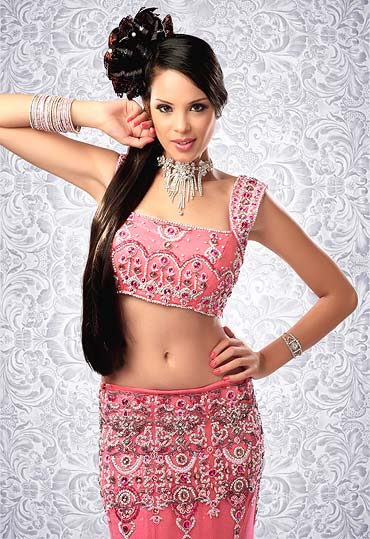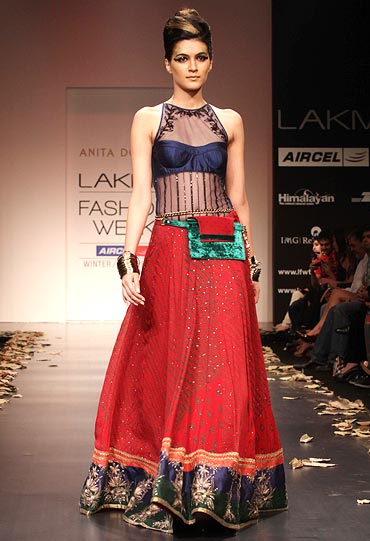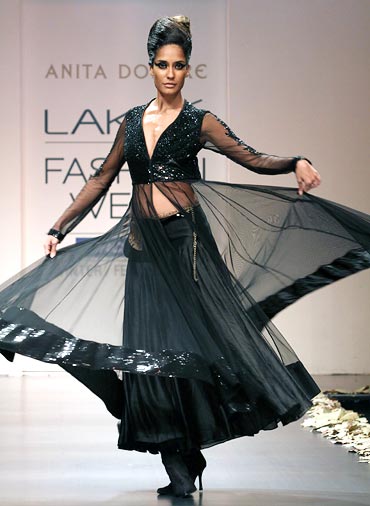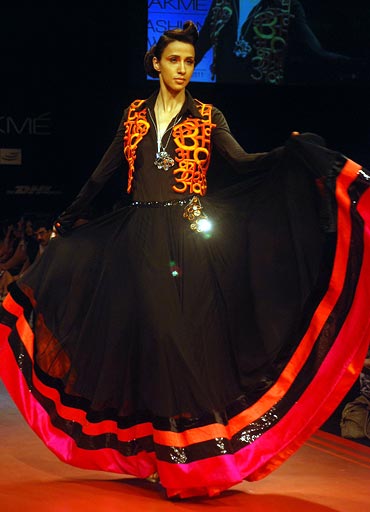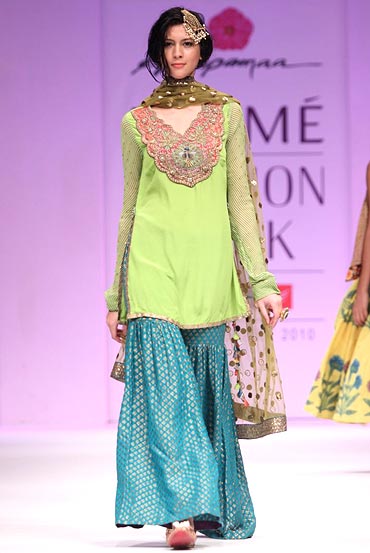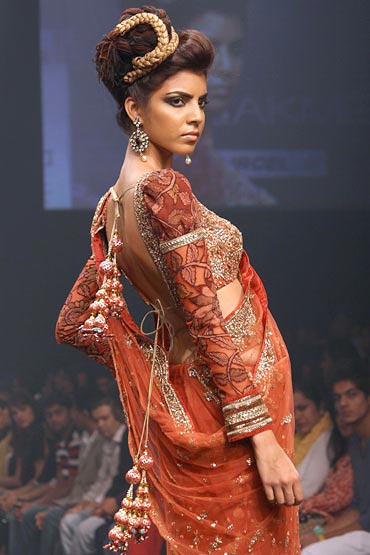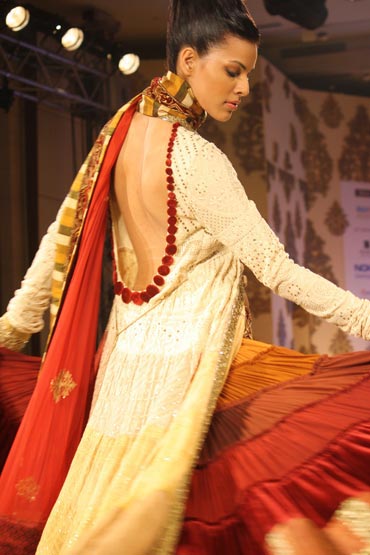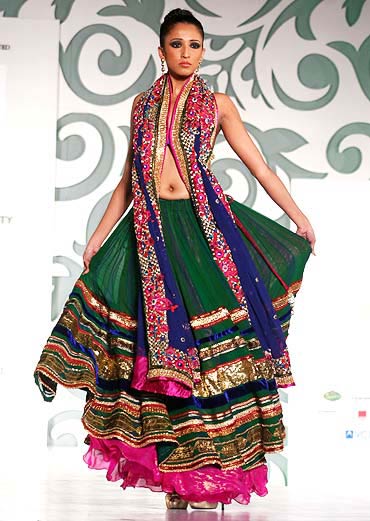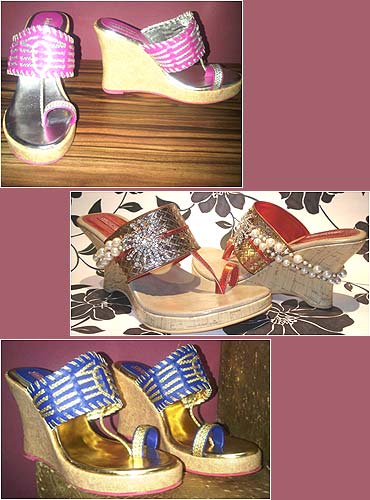 | « Back to article | Print this article |
PIX: Fashion gurus tell you how to go sexy, get dandiya-ready!
We got prominent fashion designers to weigh in on what you should wear this Navratri. Go sexy and stylish for dandiya fun courtesy their professional advice!
It's time to break out the dandiyas -- and your backless cholis, swirling lehengas and all manner of colourful, sensual ethnicwear you can think of!
The nine days of Navratri revelry commence tomorrow and if you want to put a fashionable foot forward, here's what you should be seen in this season.
'Play it like a diva'
Prominent Mumbai designer A D Singh is known for his opulent Indianwear and that's just what you need to stand out on the dance floor -- but with all those energetic dance moves, you also need to be practical.
"Play it like a diva," he says. "Since Navratri means a lot of dancing, I always recommend that women go for silhouettes which are comfortable and at the same time nice and snug in the appropriate areas. Skirts with extra flare and kalis teamed with dainty blouses or backless numbers make for killer appeal."
Continues Singh, "I love the colour palette of champagne teamed with emerald green and all silver blouses -- these are very different and very wearable! They'll bring out the diva in you and make you look extremely classy."
'For women who are not at their best fitness-wise, anarkalis provide the perfect silhouette'
"For women who are not at their best fitness-wise, long anarkalis with deep backs are the perfect cut if you're going dancing," explains the designer. "Besides the perfect silhouette they'll give you, they will bring a lot of elegance and crispness to your personality." Aside from emerald green and champagne, colour suggestions include fuschia and wine.
As for detailing on cholis, Singh suggests that you pick those encrusted with Swarovski crystals and cut deep in the back, or then entirely backless. He winds down with some wise counsel -- "Ensure you choose all blouses with sleeves if you really plan to swing and dance this Navratri." After all, you don't want to be tugging at your clothes all evening to avoid a wardrobe malfunction!
'Fabrics like bandhani, brocade and velvet are in'
Festive couturier Anita Dongre also singles out the anarkali as the garment of choice. "If you're opting for traditional classics, your outfit should be beautiful, vibrant and bright-coloured," she states. "Anarkalis embellished with traditional hand crafts and textile art work well for those who prefer to stick to tradition. A kundan piece or antique gold jewellery will complete the look well."
The designer suggests that revellers opt for fabrics like bandhani, brocade and velvet, which are in this season. Colourwise, she thinks red, maroon, shocking pink, deep blue and gold will create the right impression.
'Sheer jackets with delicate hand embroidery make a great statement'
Going the traditional route is not for everyone, however. "For those who would like to experiment a little and create their own style statement, try pairing a clean-cut jacket with sharara pants/a lehenga, or even pallazos or leggings," advises Dongre.
"Sheer jackets with delicate hand embroidery in self-colour can look fabulous and one can complete the look with beautiful, antique-finish earrings," she says. "You can even pair a traditional bandhani lehenga with a netted corset top in a contrasting shade. Accessorise with fanny packs at the waist."
'Team your skirt with a well-fitted leotard shirt and a signature statement bolero jacket'
"Whether it's Navratri or a friend's wedding, you can swirl and twirl in a perfect flared skirt or lehenga which is lightweight and so much more dramatic," enthuses Archana Kochhar. "It should be bordered to perfection with textured fabrics and sequin detailing."
Kochhar also suggests that one forego the choli and try something new and trendy for a change. "Team your skirt with a well-fitted leotard shirt and a signature statement bolero jacket, which punctuates the Indo-chic look. Stack bangles of fibre, wood and glass on your wrists and kickstart the dancing in bright heeled Kolhapuris," she says.
'Full patialas, dhoti pants and harems add soft movement'
The designer is in sync with both Singh and Dongre about the anarkali. "The billowing anarkali grows stronger this fall and transcends the territory of digitals and drapes," she says. "The classic kali panel undergoes innovation in the form of inserted godets and drape bodices. Try and team them with crushed silk skirts for a lungi effect over simple churidaars."
"The universal kurta gets a sensual uplift in the form of drape tunics with pinching and pleat detailing," continues Kochhar. "The look is paired with full patialas, dhoti pants and harems in luxe lycra, which add a soft movement to the traditional silhouettes."
'Another popular fad is colour-blocking using high-intensity colours'
Kochhar has one last suggestion when it comes to that Indian festive essential -- bling!
"In-your-face embellishments should now take a back step and let the shine of the fabric work the magic. Tone-on-tone shine embroidery is now replacing crystal-encrusted bling. The detailing is more intricate, delicate and tonal, which gives just the required shine, so that the entire ensemble sparkles with a sophisticated sheen."
Designer Anupamaa Dayal agrees. "People are now opting for less embroidered styles worn without dupattas and exposing the shoulders," she says. "For Navratri, above-ankle skirts worn with half-sleeve cholis and shararas are a new trend we see evolving. Another popular fad is colour-blocking using high-intensity colours."
'Coloured strings should be brought back'
"For me, Navratri bring in lots of colours after shrad," says designer Riyaz Gangji. "Their liveliness adds to this festive reason. Use colours like red, maroon, orange etc and avoid dark tones like blacks and blues."
"Nowadays, various variations are available in cholis through cuts like open backs, traditional tie-ups etc. Coloured strings should be brought back," he continues. "Embroidered jootis and mojaris can be worn and teamed up with jackets, patiala pants etc. One should also opt for different kinds of materials like silk, cotton, handlooms and bhagalpuri silk."
'Don't spend too much'
Adds the designer, "For men there are angardhas -- shorts kurtas that can be teamed up with coloured belts -- neon ones which give off reflection. And as for accessories, both men and women can wear pagadis in different styles like Marwari, Rajasthani etc."
When it comes to spending money, Gangji advises that you be prudent. "Always remember, don't spend too much on what you do not wear regularly," he counsels.
'Navratri is the time one can go all-out on glamour and vibrancy'
Sonya Vajifdar believes in customary styles for the festivities. "The perfect Navratri outfit would compose of colours like greens and reds, with mirror or sequence work rich in colour and embroidery," she says. "Navratri is the time one can go all-out on glamour and vibrancy."
But of course, like all the other fashion gurus, she stresses that you should be comfortable. "Your outfit should be easy to dance in," says Vajifdar. "Ghagara cholis work best with net or transparent dupattas. Also, mojris can be added with a bit of sparkle on them as well."
Footwear: 'Kolhapuri wedges are a great option'
Besides your outfit, as most designers have stressed, footwear is important. "One is required to wear comfortable shoes that give height under the ghagara," explains footwear couturier Payal Kothari of label Veruschka.
"The wedge heel is one of the most comfortable shoes to wear during this festival. It could have a touch of tradition on the design to match the attire," she adds. "Kolhapuri wedges are a great option, as they have an Indian feel to them and will match any ornate outfit one might adorn for the occasion."
